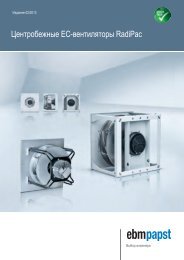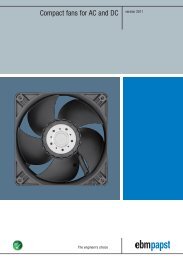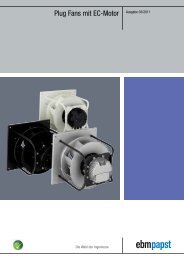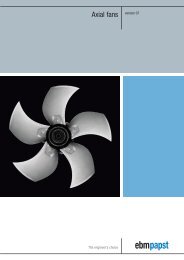Fans for rail technology version 2012-09
Fans for rail technology version 2012-09
Fans for rail technology version 2012-09
You also want an ePaper? Increase the reach of your titles
YUMPU automatically turns print PDFs into web optimized ePapers that Google loves.
Combined level of multiple same-level sound sources<br />
Adding 2 noise sources with the same level results in a level increase of approx. 3 dB.<br />
The noise characteristics of multiple identical fans can be determined in advance based on<br />
the noise values specified in the data sheet. This is shown in the diagram opposite.<br />
Example: 8 A3G800 axial fans are on a condenser. According to the data sheet, the sound<br />
pressure level of a fan is approximately 75 dB(A). The level increase measured from the diagram<br />
is 9 dB. Thus the overall sound level of the installation can be expected to be 84 dB(A).<br />
Combined level of two different-level sound sources<br />
The acoustic per<strong>for</strong>mance of two different fans can be predetermined based on the sound<br />
levels given in the data sheet. This is shown in the diagram opposite.<br />
Example: There is an axial fan A3G800 with a sound pressure level of 75 dB(A) at the operating<br />
point and an axial fan A3G710 with 71 dB(A) in a ventilation unit. The level difference is<br />
4 dB. The level increase can now be read in the diagram as approx. 1.5 dB. This means that<br />
the overall sound level of the unit can be expected to be 76.5 dB(A).<br />
Distance laws<br />
Sound power level is independent of distance to the sound source. In contrast to this, sound<br />
pressure level decreases the further away the noise source is. The adjacent diagram shows<br />
the decrease in level under far sound field conditions. Far sound field conditions apply whenever<br />
the distance between microphone and fan is big when compared to fan diameter and<br />
wavelength to be considered. For more in<strong>for</strong>mation on far sound field, please consult the relevant<br />
literature on this complex topic. Per doubling of distance, the level in the far sound field<br />
decreases by 6 dB. In the near field of the fan, other correlations apply and the decrease in<br />
levels can be considerably smaller. The following example only applies to far sound field<br />
conditions and can vary strongly depending on the installation effects:<br />
With an axial fan A3G300, a sound pressure level of 65 dB(A) was measured at a distance of<br />
1 m. According to the adjacent diagram, at a distance of 20 m we would get a reduction by<br />
26 dB, i.e. a sound pressure level of 39 dB(A).<br />
[dB]<br />
[dB(A)]<br />
Increase in sound pressure / sound power level<br />
[dB]<br />
[dB(A)]<br />
Increase in sound pressure / sound power level<br />
[dB]<br />
[dB(A)]<br />
Decrease in sound pressure level<br />
15<br />
10<br />
5 9<br />
0<br />
1<br />
2 3 4 5 6 7 8 9 10 15 20 25<br />
Number of sources of sound with identical level<br />
3<br />
2<br />
1 1,5<br />
0<br />
0 4 8 12 16 20 24<br />
Difference in level with two sources of sound<br />
[dB]<br />
[dB(A)]<br />
0<br />
-10<br />
-26 -20<br />
-30<br />
-40<br />
1<br />
Distance<br />
2<br />
5<br />
10 20 50 100<br />
[m]<br />
53








